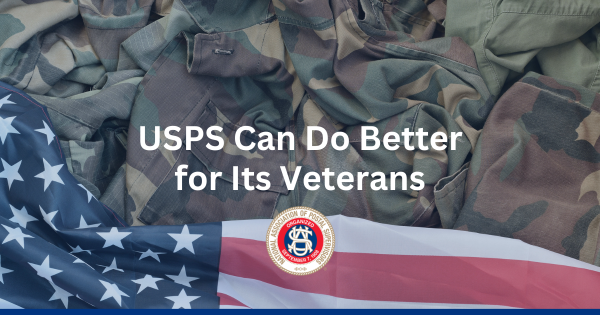USPS Can Do Better for Its Veterans
USPS Can Do Better for Its Veterans
By Ivan D. Butts
NAPS National President
Hello, my NAPS brothers and sisters. It is hard to believe it is November, but, here we are. November is a special month for many reasons. I’m sure you are thinking it is because of Thanksgiving and I like to eat, which is true.
November also is significant in its recognition of our military. Nov. 10 is the birthday of our United States Marine Corps. I am a proud father and brother of two Marines and honor those who served in this branch of our military for their unique adherence to a danger mentality in defense of America’s Constitution. As an Air Force veteran, I appreciate all our branches who take the same oath, but the Marines always will stand out to me.
The other significant day is Nov. 11—Veterans Day. World War I, known at the time as “The Great War,” officially ended when the Treaty of Versailles was signed on June 28, 1919, in the Palace of Versailles outside the town of Versailles, France. However, fighting ceased seven months earlier when an armistice, or temporary cessation of hostilities, between the Allied nations and Germany went into effect on the 11th hour of the 11th day of the 11th month. For that reason, Nov. 11, 1918, generally is regarded as the end of “the war to end all wars.”
Veterans Day continues to be observed on Nov. 11, regardless what day of the week it falls. The restoration of the observance of Veterans Day to Nov. 11 not only preserves the historical significance of the date, but also helps focus attention on the important purpose of Veterans Day: A celebration to honor America’s veterans for their patriotism, love of country and willingness to serve and sacrifice for the common good.
So, this month I would like us to consider how the Postal Service honors veterans in application of their reduction-in-force (RIF) process verses a General Services Administration (GSA) employee. In a RIF situation in the federal government, both USPS (EAS) and GSA (general schedule) employees who are veterans may receive veterans’ preference, but how that preference affects RIF retention depends on several key factors. The systems and rules governing RIF are different between the USPS and most executive branch agencies like the GSA. Let’s break down the key concepts:
1. Veterans’ Preference—During a RIF under Veterans’ Preference, certain preference-eligible veterans have an advantage in retention. This includes:
- Retention standing in their competitive area
- Preference in assignment if positions are abolished
2. Retention Standing Factors—In a typical RIF, an employee’s retention standing is determined by:
- Tenure group (e.g., career vs. career-conditional)
- Veterans’ preference status (0, 5 or 10 points)
- Service computation date (SCD) or RIF service date
- Performance ratings (last 3 years)
GSA Employee (General Schedule)—GSA is part of the competitive service, so OPM’s RIF regulations (5 CFR Part 351) fully apply. In a RIF, GSA employees are placed into retention registers using the four standard factors noted above.
The process for Veterans’ Preference for GSA employees is very strong and effective. Preference can move an employee above non-preference employees in the same tenure group. An employee could “bump” or “retreat” to other positions if eligible. Veterans can displace less-senior, non-veterans, depending on RIF rules.
This process is different for USPS EAS employees (Executive and Administrative Schedule) who are being impacted by a RIF. The USPS is not under OPM’s jurisdiction in RIFs. The USPS operates under its own RIF procedures, which are described in the Employee and Labor Relations Manual (ELM).
Key Points for USPS EAS employees:
- The USPS does consider veterans’ preference, but it differs from the GSA system.
- RIF procedures focus more on position qualifications, seniority and performance, with less-rigid retention registers.
Preference-eligible veterans in the USPS may receive some advantage, especially in placement or reassignment. However, the process for determining these placements or reassignments does not always provide advantages.
The biggest reason for this is how the USPS determines what placement or reassignment is made for the veteran. Also, the USPS does not use the exact same point system or ranking as the GSA. Veterans’ preference helps, but its impact may be less formalized or less significant than in a GSA RIF.
So, who fares better? In the GSA system (law), the process is OPM-regulated (formal) and strongly weighted in RIF retention. Bumping and retreat rights are clearly defined by RIF rules; veterans’ advantage is more clearly defined and impactful.
While the USPS system (ELM) is an internal policy, RIF retention is considered, but not strictly formulaic. Bumping is limited and subject to USPS discretion, while EAS employees have no retreat rights and the advantage to veterans potentially is less influential.
At the end of this analysis, a GSA employee with veterans’ preference likely has a clearer and stronger advantage in a RIF than a USPS EAS employee with similar pay and veteran status simply. The GSA follows stricter federal RIF rules where veterans’ preference is codified and heavily weighted.
I believe that if the USPS worked to do better in the treatment of our veterans in a RIF, it would provide more positive opportunities down the road in a RIF for non-veterans’-preference EAS employees being impacted.
In solidarity …
